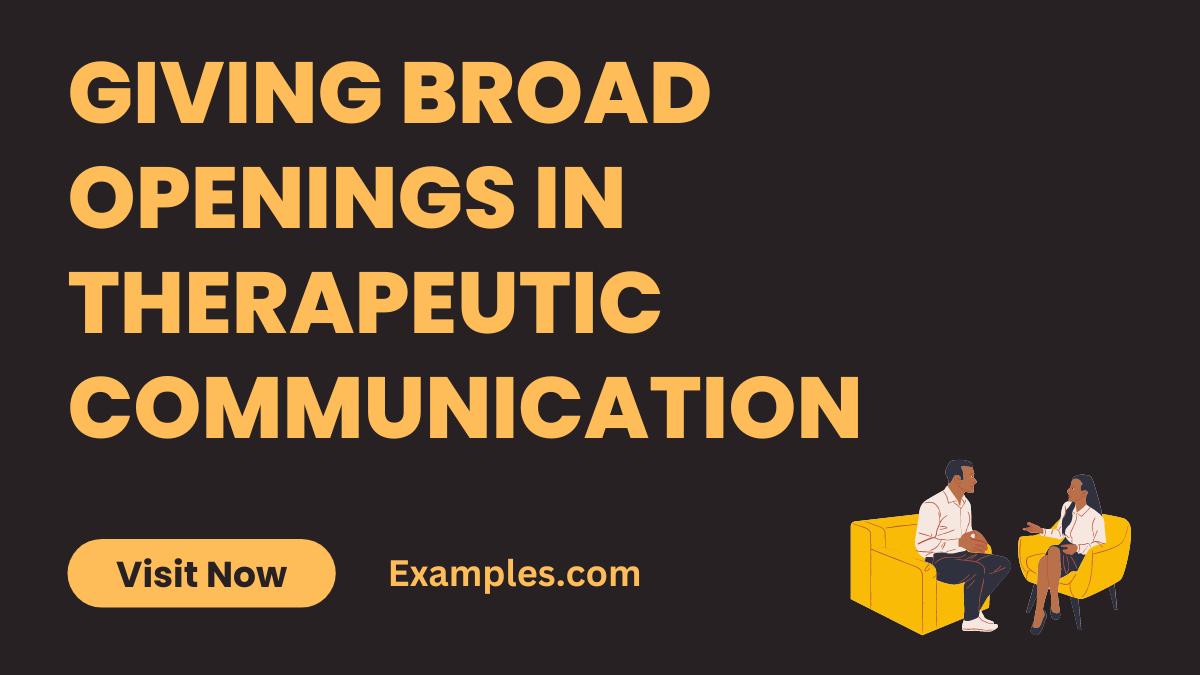19+ Giving Broad Openings in Therapeutic Communication Examples
Unlock the art of therapeutic communication with our comprehensive guide on “Giving Broad Openings in Therapeutic Communication.” Explore illuminating examples, usage insights, and expert tips to enrich your communication skills. This guide empowers you to create meaningful connections by providing a nuanced understanding of broad openings. Elevate your interactions and foster genuine dialogue with our in-depth exploration of communication examples. Master the essentials for impactful and compassionate communication in various contexts.
What is Giving Broad Openings in Therapeutic Communication?
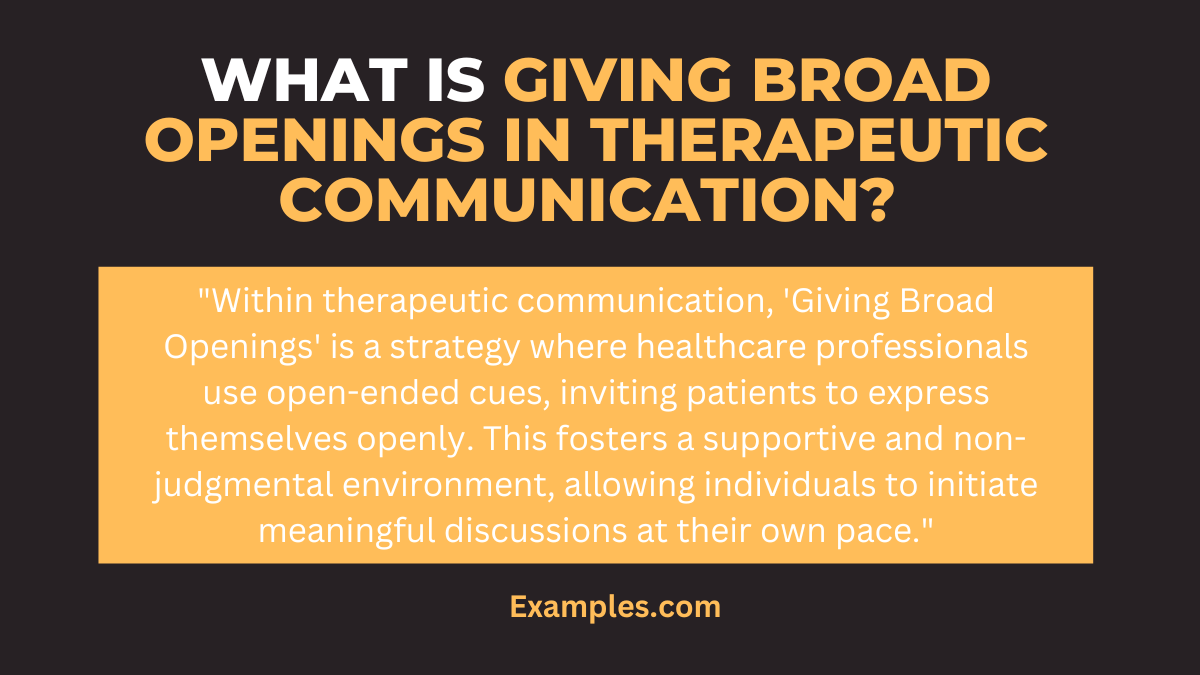
In the realm of therapeutic communication, “Giving Broad Openings” refers to a communication strategy where healthcare professionals provide open-ended cues or prompts, inviting patients to express themselves openly. This approach encourages individuals to share their thoughts, feelings, and experiences without constraint, fostering a supportive and non-judgmental environment. In simpler terms, it serves as a pathway for meaningful dialogue, allowing individuals to initiate discussions in a manner that suits their comfort and pace.
What is the best Example of Giving Broad Openings in Therapeutic Communication?
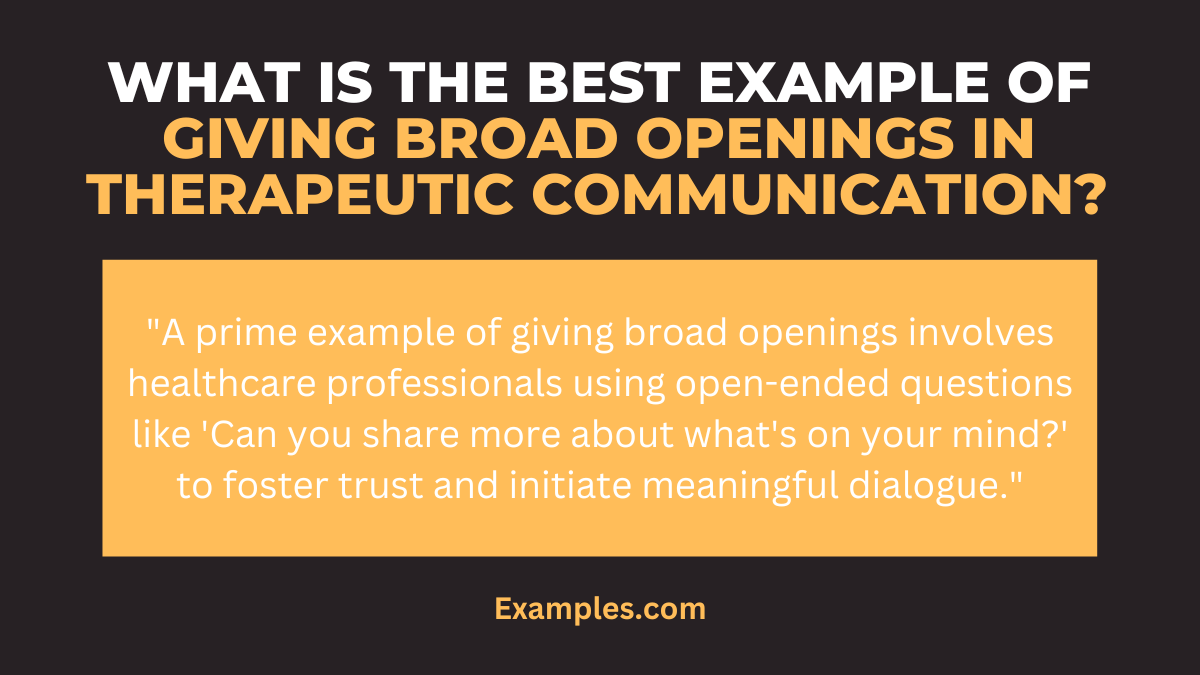
A prime example of giving broad openings in therapeutic communication involves the healthcare professional using an open-ended question such as, “Can you share more about what’s been on your mind lately?” This prompts the individual to delve into their thoughts and feelings freely, initiating a more profound conversation. By employing this broad opening, healthcare providers convey genuine interest, fostering trust, and establishing a supportive space for meaningful dialogue. This exemplifies the efficacy and significance of providing such openings in therapeutic communication.
20 Giving Broad Openings in Therapeutic Communication Examples
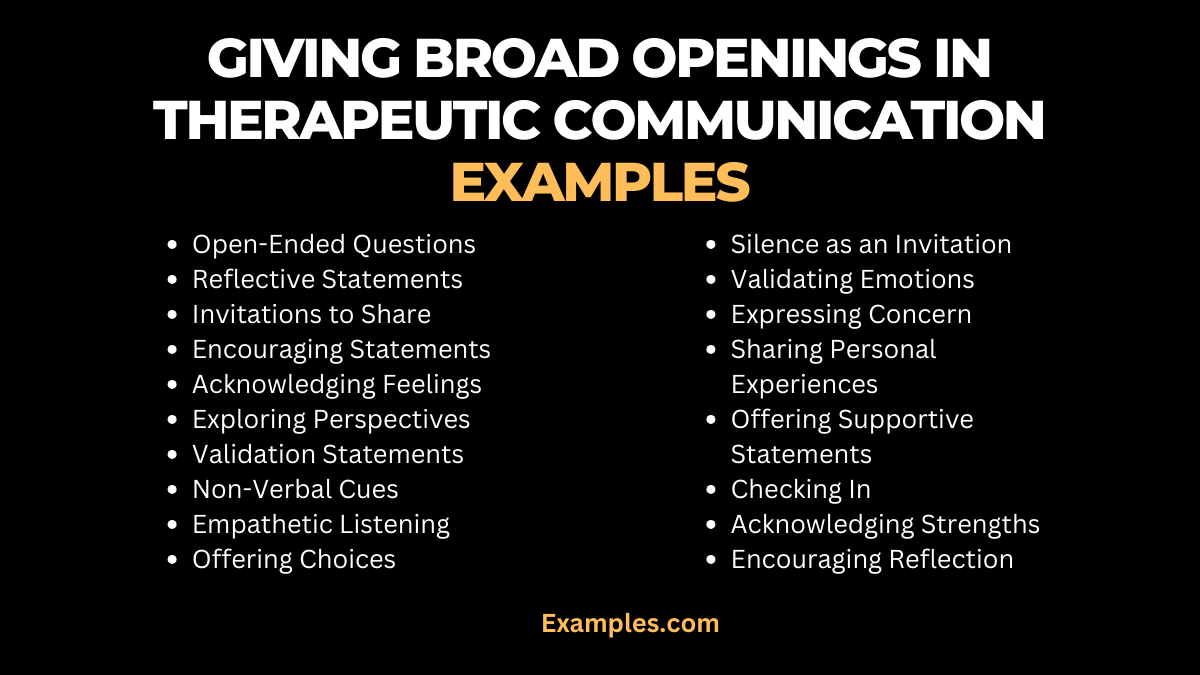
Explore these diverse examples that provide open-ended cues, encouraging individuals to express themselves openly and promoting a supportive environment for effective communication.
- Open-Ended Questions: “What’s on your mind right now?” – Use to initiate a broad conversation, allowing individuals to freely share their thoughts.
- Reflective Statements: “I sense there’s something important you’d like to talk about.” – Encourages individuals to explore their feelings and experiences.
- Invitations to Share: “Feel free to tell me as much or as little as you’re comfortable with.” – Provides a non-judgmental space for open expression.
- Encouraging Statements: “I’m here to listen whenever you’re ready to talk.” – Offers support and reassurance, inviting individuals to open up.
- Acknowledging Feelings: “It seems like there might be something on your mind. How are you feeling?” – Validates emotions and invites further discussion.
- Exploring Perspectives: “I’m interested in understanding your viewpoint. What would you like to share?” – Promotes open dialogue and mutual understanding.
- Non-Verbal Cues: “Your body language suggests there’s something important to you. Would you like to talk about it?” – Encourages expression beyond words.
- Empathetic Listening: “Take your time. I’m here to listen whenever you’re ready to share.” – Demonstrates patience and empathy, fostering trust.
- Offering Choices: “We can discuss anything that’s important to you. What topic feels most relevant today?” – Empowers individuals to choose discussion topics.
- Silence as an Invitation: “If you need time to gather your thoughts, feel free. I’m here whenever you’re ready to talk.” – Allows for reflection and comfortable sharing.
- Validating Emotions: “Your feelings matter. How can we explore them together?” – Recognizes the significance of emotions in the conversation.
- Expressing Concern: “I’ve noticed changes. Can you help me understand what you’re experiencing?” – Addresses concerns gently, prompting open communication.
- Sharing Personal Experiences: “I’ve encountered similar situations. Would you like to discuss your experiences?” – Establishes a shared understanding, encouraging openness.
- Offering Supportive Statements: “I’m here to support you. What would you like to discuss today?” – Conveys availability and willingness to engage in conversation.
- Checking In: “How are you doing today? Is there anything you’d like to talk about?” – Provides a general opening, welcoming various topics of discussion.
- Acknowledging Strengths: “Your resilience is evident. What aspects of your strength would you like to explore?” – Focuses on positive attributes, fostering empowerment.
- Exploring Goals: “What goals would you like to work towards, and how can we achieve them together?” – Engages individuals in discussing their aspirations and objectives.
- Encouraging Reflection: “Take a moment to reflect. When you’re ready, we can discuss whatever is on your mind.” – Allows time for contemplation before sharing.
- Exploring Coping Mechanisms: “How do you typically cope with challenges? Let’s explore these strategies together.” – Discusses coping mechanisms to promote well-being.
- Cultural Sensitivity: “I respect your cultural background. How can we ensure our communication aligns with your values?” – Acknowledges cultural diversity, fostering inclusive communication.
Giving Broad Openings in Therapeutic Communication For Nursing Students Examples
Empower nursing students with effective therapeutic communication through broad openings. Explore examples tailored to their learning journey for enhanced patient interactions.
- Personal Reflections: “Reflect on your experiences. How do they shape your approach to patient care?” – Encourages students to connect personal insights with nursing practice.
- Future Goals: “Consider your nursing aspirations. What steps can you take to achieve them?” – Promotes reflection on career objectives, fostering goal-oriented communication.
- Ethical Dilemmas: “Think about ethical challenges. How would you navigate these situations in patient care?” – Encourages ethical reasoning and communication skills development.
- Patient Empathy: “Imagine being a patient. What communication approach would resonate with you?” – Promotes understanding through empathy, crucial for effective nursing interactions.
- Cultural Competence: “Reflect on cultural sensitivity. How can you integrate diverse perspectives into patient communication?” – Emphasizes the importance of cultural awareness in nursing.
- Patient Advocacy: “Consider scenarios where advocacy is vital. How can you communicate effectively as a patient advocate?” – Encourages proactive communication in patient advocacy roles.
- Interprofessional Collaboration: “Imagine collaborating with healthcare teams. How can you ensure seamless communication for optimal patient outcomes?” – Highlights the significance of collaborative communication in healthcare.
- Handling Difficult Conversations: “Think about challenging discussions. How can you approach them with empathy and clarity?” – Prepares students for navigating tough conversations with patients and families.
- Self-Care Reflection: “Reflect on your self-care practices. How can you communicate your needs for a balanced nursing journey?” – Promotes self-awareness and open communication about well-being.
- Critical Thinking Scenarios: “Consider critical situations. How can you communicate decisively while considering patient well-being?” – Develops critical thinking through communication in high-stakes scenarios.
Giving Broad Openings in Therapeutic Communication for Nursing Staff
Nurture effective communication within nursing staff through tailored broad openings. These examples empower healthcare professionals to enhance patient care through open dialogue.
- Team Collaboration: “Imagine optimal team collaboration. How can you contribute to a communicative and supportive healthcare environment?” – Encourages staff to envision and foster collaborative communication.
- Patient Feedback: “Consider patient feedback scenarios. How can you initiate open conversations to address concerns and feedback?” – Guides staff in proactive patient communication and feedback integration.
- Leadership Reflections: “Reflect on leadership styles. How can you communicate effectively in your leadership role for cohesive teamwork?” – Promotes self-awareness in leadership communication within the nursing team.
- Adapting to Change: “Think about change management. How can you communicate changes effectively to maintain staff morale and patient care standards?” – Prepares staff for clear communication during organizational changes.
- Conflict Resolution: “Consider conflict scenarios. How can you use communication to navigate conflicts and maintain a positive work environment?” – Equips staff with communication strategies for conflict resolution.
- Patient Education: “Imagine educating patients. How can you tailor your communication to ensure patient understanding and compliance?” – Guides staff in effective patient education through open communication.
- Mental Health Awareness: “Reflect on mental health discussions. How can you communicate empathetically and reduce stigma around mental health?” – Addresses the importance of compassionate communication in mental health discussions.
- Quality Improvement Initiatives: “Think about quality improvement goals. How can you communicate changes to improve patient care outcomes?” – Highlights the role of effective communication in driving quality improvement initiatives.
- Staff Well-Being: “Reflect on staff well-being. How can you foster open communication to support your colleagues’ mental health?” – Promotes a culture of open communication for staff support and well-being.
- Patient-Centered Care Plans: “Consider creating patient care plans. How can you involve patients in decision-making through effective and open communication?” – Guides staff in patient-centered communication for care planning.
What is the importance for Giving Broad Openings in Therapeutic Communication?
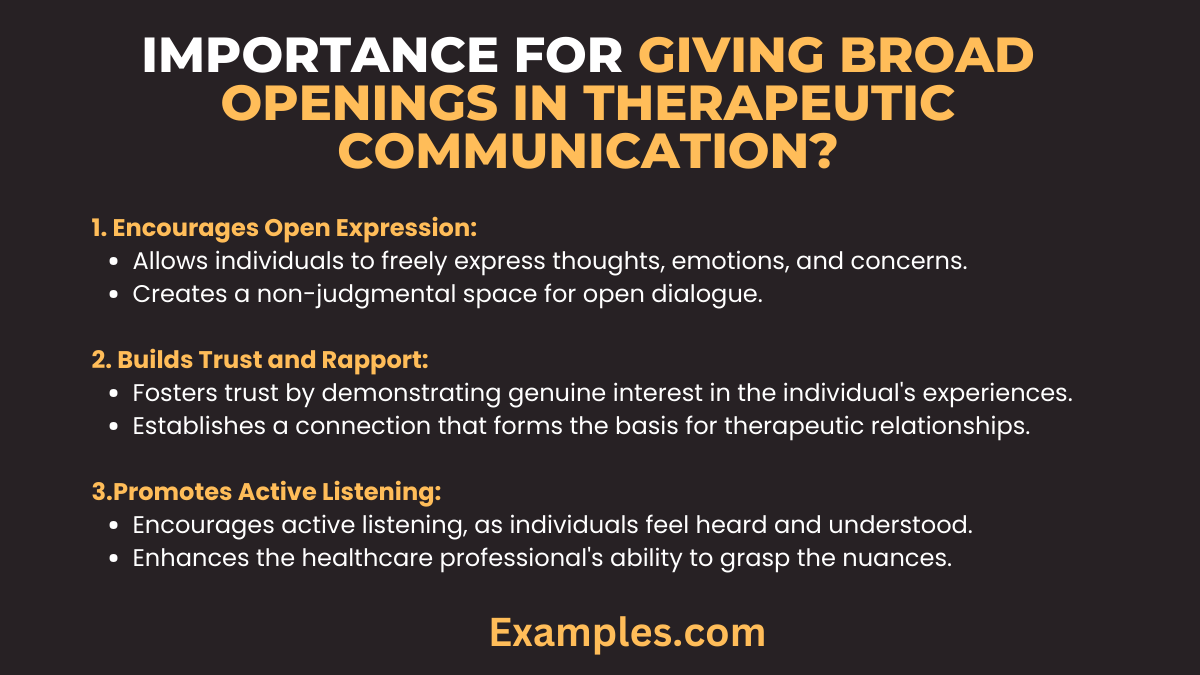
Therapeutic communication, particularly the practice of giving broad openings, plays a crucial role in fostering effective and meaningful interactions between healthcare professionals and individuals seeking support. Understanding the importance of this communication strategy is essential for creating a supportive and healing environment. Explore the significance in points:
- Encourages Open Expression:
- Allows individuals to freely express thoughts, emotions, and concerns.
- Creates a non-judgmental space for open dialogue.
- Builds Trust and Rapport:
- Fosters trust by demonstrating genuine interest in the individual’s experiences.
- Establishes a connection that forms the basis for therapeutic relationships.
- Promotes Active Listening:
- Encourages active listening, as individuals feel heard and understood.
- Enhances the healthcare professional’s ability to grasp the nuances of the individual’s experiences.
- Addresses Varied Communication Styles:
- Recognizes and accommodates diverse communication preferences.
- Allows for personalized and patient-centric approaches.
- Initiates Meaningful Conversations:
- Serves as a catalyst for discussions that delve into deeper aspects of the individual’s well-being.
- Helps uncover underlying concerns that may not be immediately apparent.
How do you provide a broad opening as a therapeutic communication?
Therapeutic communication thrives on open-ended cues that invite meaningful dialogue. Here’s a detailed guide on providing broad openings to enhance patient interactions:
- Begin with Empathy: Start conversations with a genuine expression of understanding and empathy, setting the tone for an open exchange.
- Use Open-Ended Questions: Craft questions that encourage detailed responses, allowing individuals to express themselves freely.
- Create a Safe Environment: Foster trust by establishing a non-judgmental and safe space where individuals feel comfortable sharing their thoughts.
- Promote Reflective Listening: Engage in reflective listening, acknowledging and paraphrasing the individual’s feelings to validate their experiences.
- Encourage Self-Expression: Offer invitations for individuals to share their thoughts and emotions without fear of judgment or interruption.
In conclusion, mastering the art of providing broad openings in therapeutic communication is pivotal for fostering genuine connections. This comprehensive guide has explored impactful examples and strategies, empowering individuals to initiate open dialogue. By incorporating these techniques, practitioners can create a supportive environment, facilitating meaningful conversations and enriching the overall therapeutic experience.



